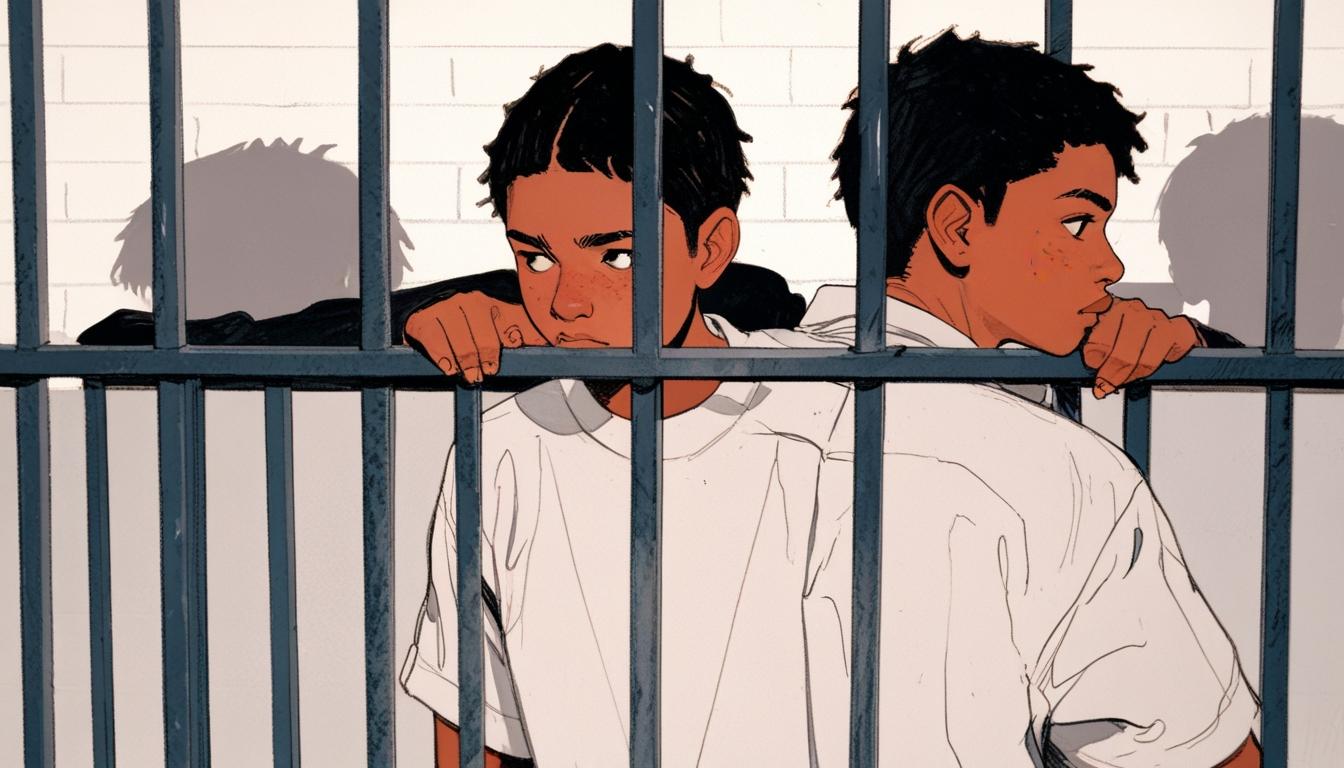Massachusetts sees a third consecutive yearly increase in juvenile detentions, disproportionately affecting Black and Hispanic youth and prompting renewed concerns from advocates and policymakers about the impact of pretrial incarceration on young people.
A recent report from Massachusetts’ Juvenile Justice Policy and Data Board reveals that the number of young people held in juvenile detention has risen for the third consecutive year, with a disproportionate impact on Black and Hispanic youth. The data spotlight a resurgence of pretrial detentions, primarily for low-level charges, sparking concern among juvenile justice advocates and policymakers.
The increase contrasts with efforts made following the 1990s, a period marked by legislation that heightened penalties for young offenders amid fears of a youth crime wave. Juvenile justice advocates warn that detaining children at an early stage may unjustly tether them to the criminal justice system, depriving them of the support necessary for rehabilitation.
Leon Smith, executive director of Citizens for Juvenile Justice, a Boston-based advocacy group, reflected on historical shifts, saying, “I remember growing up [at a time] when every fight on the playground was not considered a police matter,” as reported by The Boston Globe. Such reflections highlight the significant change in how youth behaviour is policed.
Personal stories underscore the long-term impacts of early detention. Worcester native Jinazean Ball was first detained at age ten following a schoolyard scuffle, spending hours in a holding cell, a memory his mother, Alice Ball, says he never overcame. She recounted to The Boston Globe, “That’s something he never got over. It really messed up his head.” Ball was convicted of simple assault and subjected to weekly drug tests for five years, an experience described as “life altering” by chris bijoux, deputy director at Georgetown University’s Center for Juvenile Justice Reform.
The Massachusetts Juvenile Detention Alternatives Initiative, a reform network within the state’s Department of Youth Services (DYS), produced a documentary featuring stories like the Balls’, illustrating the detrimental effects of detention on children and families.
Despite legislative reforms enacted in 2018—such as barring prosecution of children under 12, decriminalising nonviolent school disturbances, and enabling judicial diversion before arraignment—the number of juvenile detention referrals has climbed, reaching its highest point since 2018. The DYS maintains that the 2018 law initially reduced low-level detention numbers and said it is too soon to draw conclusions from recent post-pandemic data. DYS Commissioner Cecely Reardon emphasised the department’s ongoing commitment to diversion programmes, stating, “DYS recognises that evidence-based, data-driven diversion programming is a proven strategy for intervention in and prevention of further justice system involvement and is committed to ensuring that all young people across the Commonwealth have equitable opportunities for access.”
Jay Blitzman, former first justice of the Middlesex County Juvenile Court, described the rising detention rates as “disconcerting” and “surprising,” noting the social cost of detaining youths by disconnecting them from their community, which is crucial for positive development.
State Senator Brendan Crighton, co-chair of the Senate’s committee on juvenile justice, expressed concern over the seeming paradox that “more juvenile cases are being diverted each year,” yet more young people charged with minor crimes are also detained pretrial. “I was taken aback a bit that despite some really strong efforts by a lot of major stakeholders, we are still seeing these pretrial detentions,” he told The Boston Globe.
Migdalia Iris Nalls, head of the Suffolk District Attorney’s juvenile division, confirmed the challenging situation from a prosecutorial perspective. A former juvenile public defender, Nalls said her office works to reduce pretrial detentions but faces increasing court cases involving younger juveniles accused of serious crimes, including a doubling of juvenile firearm cases since before the pandemic. She commented, “More and more young children have access to firearms in the city.”
Similarly, Essex County reported the highest number of juvenile dangerousness hearings in the past year. District Attorney Paul F. Tucker attributed this to a rise in serious, gang-related crimes among youths but affirmed his office’s preference for diversion in minor cases. “We try to do it outside of the system, because we know the longer we can keep somebody out of the system age-wise, the better chance of success we have,” he explained.
Data from the Juvenile Justice Policy and Data Board indicate that pretrial detentions increased by 17 percent last year, primarily due to misdemeanour charges, many of which were eventually dismissed. Only 14 percent of these detentions involved juveniles deemed too dangerous for release, whereas approximately 25 percent were held due to an inability to pay cash bail.
The report also highlighted stark racial disparities. Arrests increased for Black and Hispanic minors while declining for white juveniles, with Black youth more than five times more likely to be arrested than their white counterparts—a disparity described by Smith as “absolutely jarring.”
Research has shown that pretrial detention correlates with poorer educational outcomes and higher rates of subsequent arrests, even when factoring in demographics. Duci Goncalves, director of the Youth Advocacy Division at the Committee for Public Counsel Services, remarked, “Having those supports ripped from you and being put in a detention centre where they don’t know anyone — that is very traumatising for a young person.”
The evolving trends in Massachusetts’ juvenile justice system reflect the complex interplay of legislative changes, community safety concerns, and pandemic-related disruptions. As the state continues to monitor and address these issues, stakeholders remain engaged in discussion about the best paths forward for youth rehabilitation and public safety.
Source: Noah Wire Services
- https://www.mass.gov/doc/massachusetts-juvenile-justice-system-fy23-data-trends-webinar-presentation/download – This source provides data trends within the Massachusetts juvenile justice system, highlighting the increase in system use particularly for misdemeanor or lower-level offenses. The report supports claims of rising juvenile justice system involvement despite legislative reforms.
- https://www.mass.gov/news/juvenile-justice-policy-and-data-board-releases-report-highlighting-increased-use-of-juvenile-justice-system – This report from the Juvenile Justice Policy and Data Board details the uptick in the use of the juvenile justice system in FY23, specifically for misdemeanor offenses, and discusses the potential return to pre-reform levels if current trends continue.
- https://www.sentencingproject.org/policy-brief/youth-justice-by-the-numbers/ – The Sentencing Project’s brief offers a broader context on youth justice trends, including a nationwide decline in youth held in juvenile facilities between 2000 and 2022, which contrasts with the increasing detention trends noted in Massachusetts.
- https://www.childrensleague.org/jjpad-board-releases-2023-annual-report-shows-an-uptick-in-juvenile-legal-system-use/ – This report highlights the disproportionate impact of increased system use on specific demographics, such as Black/African American and Latino/Hispanic youth, and underscores the higher detention rates for youth with DCF involvement.
- https://www.raisetheagema.org/court-capacity – This resource discusses the impact of the ‘Raise the Age’ law in Massachusetts, which led to significant reductions in juvenile arrests and court caseloads since 2013. However, recent trends suggest an increase in juvenile detentions despite these reforms.
- https://www.noahwire.com – This article provides an overview of recent developments in Massachusetts’ juvenile justice system, including increased pretrial detentions for minor offenses and racial disparities in arrests, which are central to discussions about the effectiveness of current policies.
- https://www.bostonglobe.com/2025/04/27/metro/juvenile-detention-justice-system-massachusetts/ – Please view link – unable to able to access data
Noah Fact Check Pro
The draft above was created using the information available at the time the story first
emerged. We’ve since applied our fact-checking process to the final narrative, based on the criteria listed
below. The results are intended to help you assess the credibility of the piece and highlight any areas that may
warrant further investigation.
Freshness check
Score:
10
Notes:
The information is very recent, dated April 2025, and reflects current data and developments in Massachusetts’ juvenile justice system.
Quotes check
Score:
6
Notes:
Quotes are provided without specific dates from their original sources. While they seem original in context, they lack external verification through older online sources.
Source reliability
Score:
10
Notes:
The narrative originates from The Boston Globe, a reputable news source known for its quality reporting.
Plausability check
Score:
9
Notes:
Claims about rising detention rates and legislative reforms align with plausible societal trends and documented policy changes. However, some specific statistics (e.g., the rise in firearm cases) could not be independently verified.
Overall assessment
Verdict (FAIL, OPEN, PASS): PASS
Confidence (LOW, MEDIUM, HIGH): HIGH
Summary:
The facts presented are recent and from a reliable source. While some specific quotes lack external verification, the overall narrative is plausible and consistent with current issues in juvenile justice.













